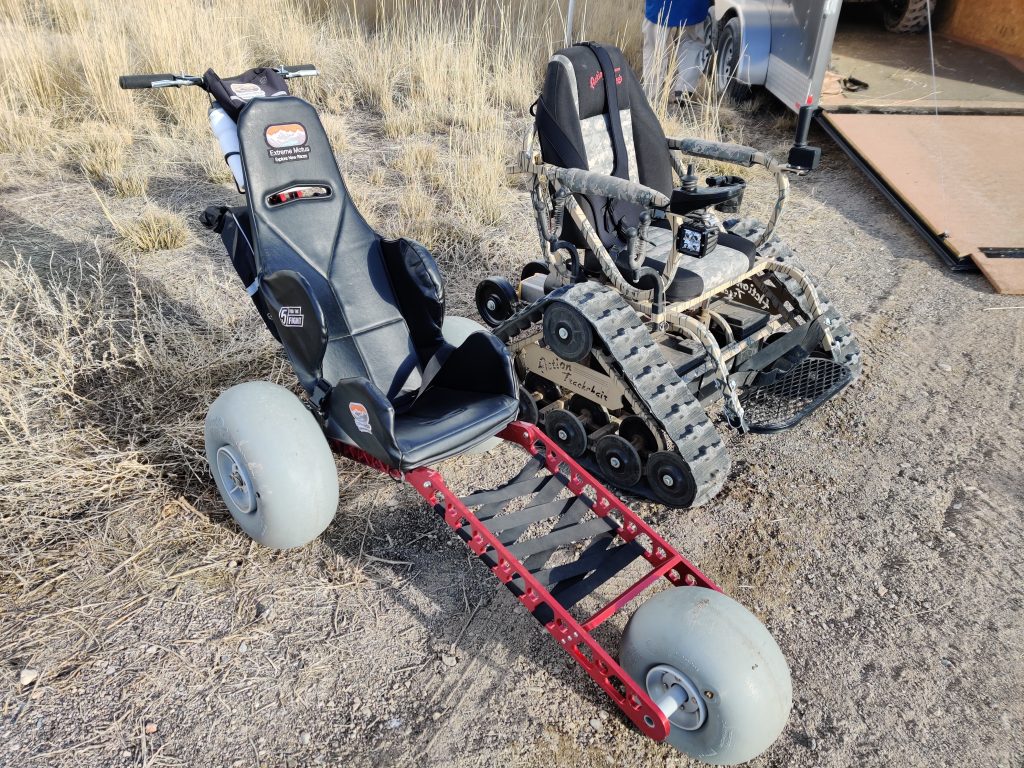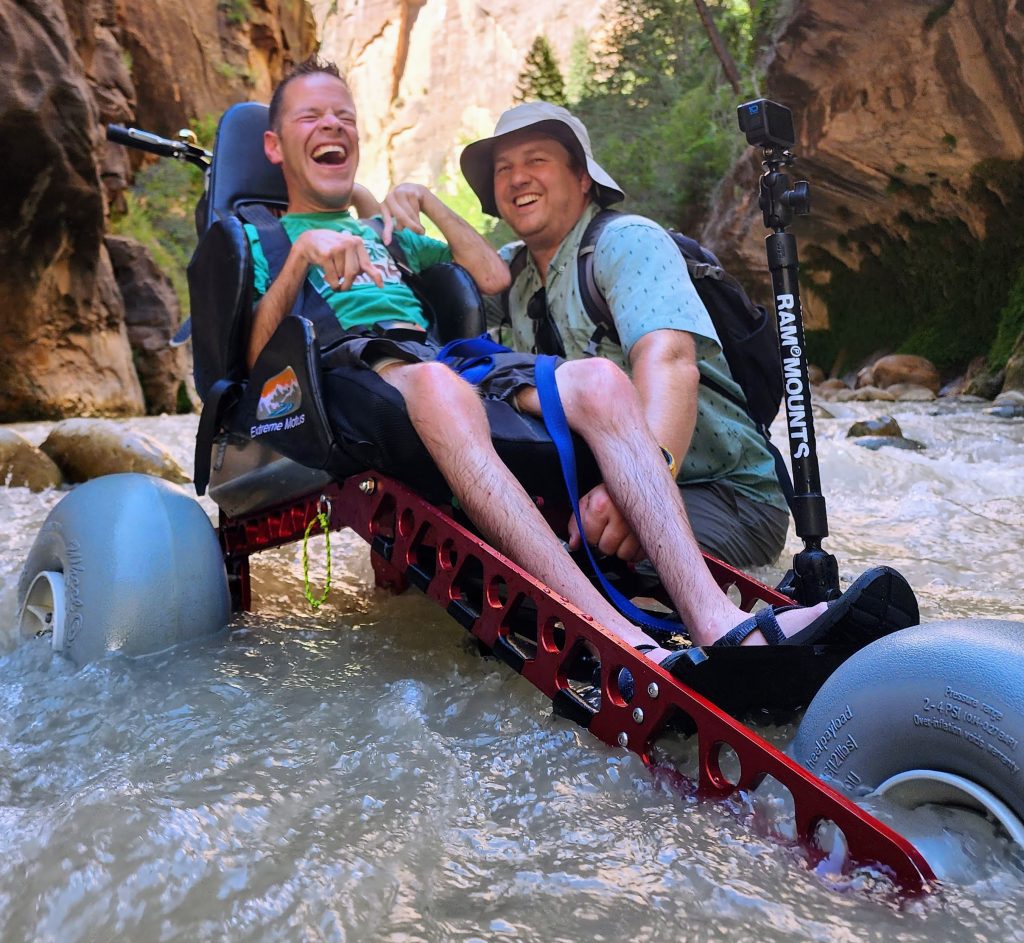Manual vs. Powered All-Terrain Wheelchairs
As the global focus on accessibility grows, the great outdoors has become increasingly open to people with disabilities, thanks to innovations in adaptive equipment like hiking wheelchairs.
The freedom to explore nature’s trails should be a universal pleasure, and for individuals who rely on wheelchairs for mobility, this freedom hinges on the availability of the right tools.
In this comprehensive guide, we will examine the nuances of manual vs powered all-terrain wheelchairs, aiding you in deciding which option may best suit your adventurous spirit and needs.
Manual vs Powered All-Terrain Wheelchairs
Access to nature and outdoor recreation is a crucial aspect of quality of life for many. For wheelchair users, it means finding a balance between the desire for rugged adventure and the need for practical, reliable support.
Many people look at powered wheelchairs as the perfect solution without thinking of their downsides. Both Manual vs powered all-terrain wheelchairs have their pros and cons.
Manual All-Terrain Wheelchairs
Features and Benefits of Manual All-Terrain Wheelchairs:
Manual all-terrain wheelchairs are engineered to provide sturdy, dependable transport over a variety of terrains without the need for batteries or electronic controls.
They are lighter than their powered counterparts and can fold down for easier transportation to your starting point and much more affordable.
Considerations for Users of Manual All-Terrain Wheelchairs:
Selecting a manual all-terrain wheelchair generally means considering the user’s upper body strength to push themselves, or support group of friends, family members, and caretakers who are available to push them in a manual all-terrain wheelchair like the Extreme Motus Manual All-Terrain Wheelchair.
Comfort, fit, and the type of terrain you intend to conquer are also pivotal when choosing a manual option.
Powered All-Terrain Wheelchairs

Features and Benefits of Powered All-Terrain Wheelchairs:
Powered AllTerrain wheelchairs offer a level of independence that can be hard to achieve with manual chairs.
Equipped with durable batteries and motors, these wheelchairs are designed to take on steeper inclines and more rugged terrain with ease.
Considerations for Users of Powered Hiking Wheelchairs:
For those debating a powered all-terrain wheelchair, important considerations include battery life, ease of control, and the chair’s weight.
It’s also key to factor in the availability of power sources for recharging on longer trips and the overall maintenance needs.
Consider how you will transport a powered chair that can weigh up to 400-500 pounds. Along with the cost of a powered all-terrain wheelchair estimated at $15,000 you may also need to purchase a truck and trailer to move this equipment from your home to the trail you wish to explore.
Comparing Manual vs Powered All-Terrain Wheelchairs
When deliberating between Manual vs powered all-terrain wheelchairs, one may wish to weigh several aspects:
Cost: Powered wheelchairs are usually a significant investment compared to manual options.
Maneuverability: Manual chairs may demand more skill to navigate, while powered chairs typically offer smoother handling.
Terrain Accessibility: Powered wheelchairs are often more capable in varying terrains, though advancements in manual wheelchair design are closing this gap.
Physical Exertion: This is a considerable factor, especially for those who may not have the physical strength to manage a manual wheelchair on uneven ground.
User Preferences and Needs: Personal circumstances, such as the nature of one’s disability, will significantly influence the decision.
Case Studies and User Experiences
To illustrate the impact of manual vs powered all-terrain wheelchairs this choice, let’s look at real-life examples:
Sam who stars in our videos has cerebral palsy. His disability affects his upper and lower body. Sam is unable to control a powered all-terrain wheelchair. He uses the Extreme Motus all-terrain wheelchair with the help of a friend or family member. The lightweight, inexpensive Extreme Motus has allowed Sam and his family to visit many amazing places.
Sarah, who values autonomy and prefers not to rely on others for pushing or navigating, chose a powered hiking wheelchair. Her chair has taken her from sandy beaches to forested paths without assistance. Sarah also has the equipment like a truck and trailer to transport her powered all-terrain wheelchair as well as the budget to purchase all these things.
Choosing the Right Option
As you decide between manual vs powered all-terrain wheelchairs consider the following to make an informed decision:
Start by assessing the typical terrains you will encounter and the necessary wheelchair durability to match.
Reflect on the level of physical capability and whether the additional exercise of a manual chair is desirable.
Consider the long-term value; while powered chairs might be costlier upfront, they may offer more independence and accessibility.
Consultation with healthcare professionals and adaptive equipment specialists can provide wisdom tailored to your specific situation.
Conclusion
With the myriad of factors to account for, selecting the ideal hiking wheelchair is undeniably personal and paramount.
Whether you tilt towards the powered models’ ease or the active engagement of manual chairs, the right choice is the one that best aligns with your lifestyle, desires, and mobility needs.
Let the right adaptive equipment empower you to breathe fresh air into your life, challenge yourself, and revel in the sensory feast nature offers.
Keep rolling forward, exploring every path and trail wheelchair technologies put within reach, and never let the spirit of adventure be dimmed by disability.
Remember, from Accessible Trail Gear to All Terrain Wheelchairs, being informed is your first step to enjoying the freedom and wonders of hiking regardless of mobility challenges.
Join us across the beautiful landscapes and make memories that elevate the soul and spirit.

Are you ready to dive deeper into the world of manual vs powered all-terrain wheelchairs?
Join us in discovering the Extreme Motus manual all-terrain wheelchair.
Let’s venture together to unveil how it masterfully combines durability with the joy of manual mobility. This isn’t just about traversing new terrains; it’s about reclaiming freedom and crafting stories etched with the essence of pure determination.
For more tales of triumph and to learn how the Extreme Motus can be part of your next great adventure, reach out to us. We’re here to embark on this journey with you, every roll of the way.
Together, let’s touch the horizon where the sky kisses the rugged earth — your journey awaits.
If your heart is stirring with the call of the wild, if the whispers of the wind through the trees beckon you to new adventures, we’re here to join you in answering that call.
Reach out to our fellow trailblazer, Ryan, who’s not just a guide but a companion on this journey toward liberation and joy.
Whether you prefer a call to hear the empathy in a human voice or a text for a quick exchange of ideas, just reach out at ryan@extrememotus.com or give a ring at (801) 683-9191.
Ryan stands ready to craft a pathway through nature that’s as unique as your indomitable spirit.
Together, let’s not just dream about destinations; let’s discover them.
Every year, more families discover the freedom these chairs create—this Black Friday, demand is already building fast. By joining the early-access list, you secure your chance to order before the sale goes public on November 28, 2025.
Since 2019, Sam and Ryan have been demonstrating that nature is wheelchair accessible with the Extreme Motus All Terrain Wheelchair. From National Parks to Skateparks, their adventures prove that a manual off-road wheelchair can offer laughter and joy while navigating diverse terrains.
Join us as we continue to share these inspiring journeys.

Light, comfortable, and compact, the Extreme Motus glides over sand, rocks, grass, gravel, and even floats in water.
It’s more than a outdoor wheelchair; it’s your ticket to freedom. Embrace the outdoors with confidence, knowing our off-road wheelchair is engineered for durability and ease of use.
Be the first to hear about new gear, upcoming adventures, and exclusive offers. As a welcome gift, enjoy $10 off your first Motus T-Shirt when you subscribe.
By subscribing you agree to receive marketing communications from Extreme Motus, including product updates, promotions, and special offers. I understand I can unsubscribe at any time.



